Traveling doesn’t seem to lend itself to weaving, for some reason. My suspicion is that it requires a block of time when one isn’t on the beach. This summer, I wisely warped my looms for weaving before I left. When we returned, I sat right down and started weaving. As is often the case, I am inspired by my fellow island weavers – they never cease to give me food for thought and I count myself seriously lucky to have such creative and brilliant friends. Although this post is a bit technical, I hope there are pictures enough to keep it enjoyable.
Towels
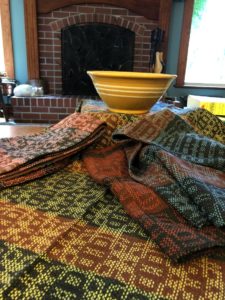 First off the loom were some big and bold towels based on the square-within-a-square pattern I have been stuck on for a while. These towels use the summer/winter weave structure. I wove this structure on one of my first major projects using pick-up to cre
First off the loom were some big and bold towels based on the square-within-a-square pattern I have been stuck on for a while. These towels use the summer/winter weave structure. I wove this structure on one of my first major projects using pick-up to cre ate music (hmmm – it has been awhile – I might have to try that again), but this time I was playing with the blocks. If you look at the pictures to the right, I think you can see how the shapes evolved. By the time I worked on this last set of towels, the blocks became pretty abstract but I still love the concept. These towels are cotton with two brown tones as warp and various weft colors.
ate music (hmmm – it has been awhile – I might have to try that again), but this time I was playing with the blocks. If you look at the pictures to the right, I think you can see how the shapes evolved. By the time I worked on this last set of towels, the blocks became pretty abstract but I still love the concept. These towels are cotton with two brown tones as warp and various weft colors.
My second project used a lovely combination of fall colors in the warp and an undulating twill structure. What makes this set of dish towels unique is the weft material – a cotton boucle. The 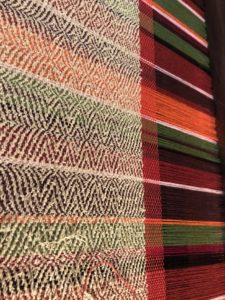 undulating twill emphasizes the weft (weft-dominant) materials so the colors obscure the warp colors to a large extent. Still there are hints of them shining through and they add a richness to the overall look, I think. The only regret? The pink! Even though the colors all seemed sweet together on the bobbins, once that pink creation happened, well, it reminds me of that glop we take when our stomach is upset.
undulating twill emphasizes the weft (weft-dominant) materials so the colors obscure the warp colors to a large extent. Still there are hints of them shining through and they add a richness to the overall look, I think. The only regret? The pink! Even though the colors all seemed sweet together on the bobbins, once that pink creation happened, well, it reminds me of that glop we take when our stomach is upset. 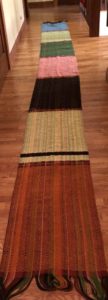 Not ideal. I do wish you could feel them though. They have a thick, rough texture which I think is quite satisfying for drying in the kitchen. As you can see on the right, the warp accommodated 7 dish towels of generous size. I washed them as a unit, then cut them apart and hemmed them. I am keeping the orange-ish one for myself.
Not ideal. I do wish you could feel them though. They have a thick, rough texture which I think is quite satisfying for drying in the kitchen. As you can see on the right, the warp accommodated 7 dish towels of generous size. I washed them as a unit, then cut them apart and hemmed them. I am keeping the orange-ish one for myself.
Blankets
My major effort was my two new blankets. This time I may have attempted a slightly ambitious project and I learned more than I bargained for. Last year I wove a straight twill. This year: rosepath. I warped two blankets which required 7 yards (in this case, 20 skeins of yarn). I weave these blankets double width, which means I weave both 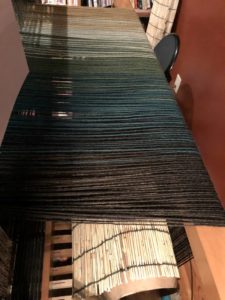 sides of the blanket at the same time. Imagine two weaving planes on top of each other where you close one side and keep the other one open. When removed from the loom, I can open up the fabric and the width will be double that on the loom. I wanted to have the yarn fade from color to color, so I wound 4 strands at a time, slowly replacing colors as I moved across the warp. I loved the result (see photo on the left).
sides of the blanket at the same time. Imagine two weaving planes on top of each other where you close one side and keep the other one open. When removed from the loom, I can open up the fabric and the width will be double that on the loom. I wanted to have the yarn fade from color to color, so I wound 4 strands at a time, slowly replacing colors as I moved across the warp. I loved the result (see photo on the left).
Rosepath isn’t super complicated, but when combined with double-width, it can get a little confusing – both in the threading of the loom and the treadling during weaving. I could not keep track of the treadling order for more than five seconds at a time. Luckily, looms are such flexible machines. The treadles can be connected to the shafts in any order one likes – it is a simple matter to decide to change the approach. Lesson 1: For the weav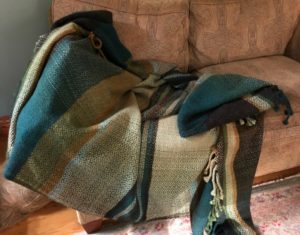 ers among you, I switched from a walking tie-up to one that worked from left to right and back again. This allowed me to stay on track, find myself when I had been away, and generally be much happier with the process.
ers among you, I switched from a walking tie-up to one that worked from left to right and back again. This allowed me to stay on track, find myself when I had been away, and generally be much happier with the process.
And, of course I ran out of yarn on the second blanket. 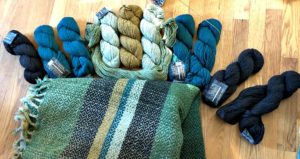 The picture on the left was my design approach to use up everything I had and 4 new skeins. I took the highly technical approach of throwing everything on the floor and pushing things around until I liked the result. Looking down on it from standing gave me the right perspective to see how the colors would work together. Lesson 2: rosepath has bigger floats so it uses more yarn. Plan ahead and buy more than I need?
The picture on the left was my design approach to use up everything I had and 4 new skeins. I took the highly technical approach of throwing everything on the floor and pushing things around until I liked the result. Looking down on it from standing gave me the right perspective to see how the colors would work together. Lesson 2: rosepath has bigger floats so it uses more yarn. Plan ahead and buy more than I need?
Taking a blanket off the loom is not the end of the story. 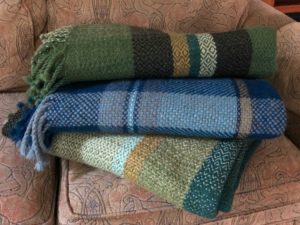 There are ends to weave in and fringe to twist. Then they each get a bath and a little bit of agitation in a top loading washer so they are “fulled.” The result is a soft, heathery look and a dense, warm fabric – perfect for a winter evening snuggled up in a chair or on a couch. The picture on the right shows the 2 new blankets with last year’s in between. Do you like the new pattern better?
There are ends to weave in and fringe to twist. Then they each get a bath and a little bit of agitation in a top loading washer so they are “fulled.” The result is a soft, heathery look and a dense, warm fabric – perfect for a winter evening snuggled up in a chair or on a couch. The picture on the right shows the 2 new blankets with last year’s in between. Do you like the new pattern better?
All in all, it was a productive couple of months. Now it is time to snuggle in and get ready for the holidays. I hope you all have a wonderful year end.
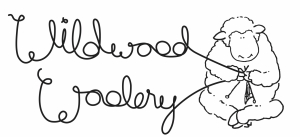
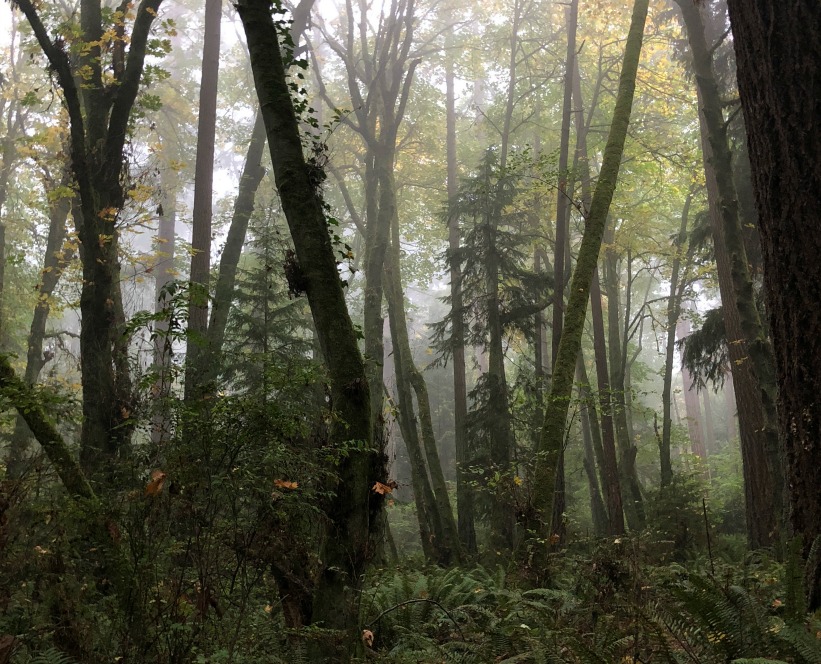
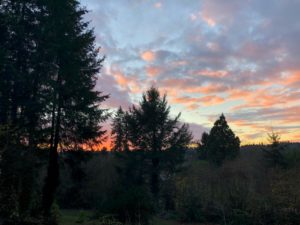
Leave A Comment